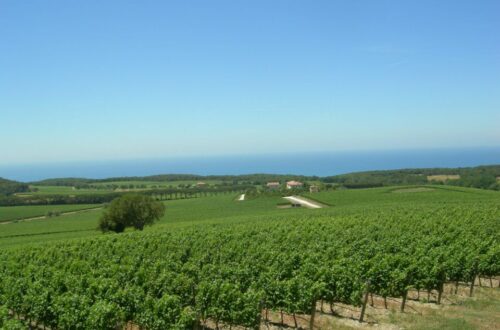Aleatico di Puglia DOC Overview
- Region: Puglia (Apulia), Southern Italy
- Grape: 85–100% Aleatico, sometimes blended with Negroamaro, Primitivo, or Malvasia Nera
- Styles: Dolce Naturale, Liquoroso, and Riserva
- Production: Extremely limited, considered a rare Italian dessert wine
- Price Range: €25–€60+ depending on style and vintage
Best For: Dessert pairings, collectors of rare Italian wines, and travelers seeking authentic Puglian culture
Table of Contents
What is Aleatico di Puglia DOC?
Aleatico di Puglia DOC is one of Southern Italy’s hidden treasures—a luscious, aromatic dessert wine made from the rare Aleatico grape. Found throughout Puglia, it carries centuries of history yet remains one of the region’s most underappreciated gems. Its sweet, perfumed character makes it stand out in the Italian dessert wine canon, alongside icons like Moscato di Trani and Aleatico dell’Elba.
Aleatico di Puglia DOC History: From Ancient Greece to 1973 Classification
The Aleatico grape likely arrived in Puglia with the ancient Greeks, who colonized the southern Italian coasts. Loved for its heady aromatics and deep flavors, Aleatico was historically reserved for special occasions and noble courts.
In 1973, Aleatico di Puglia was officially recognized as a Denominazione di Origine Controllata (DOC), protecting both tradition and production quality. Despite its DOC status, production has always remained scarce—cementing its status as a rare find.
Puglia Wine Region: Mediterranean Terroir for Aleatico Grapes
Stretching along Italy’s heel, Puglia is bathed in Mediterranean sun and caressed by breezes from both the Adriatic and Ionian seas.
- Soils: Rich limestone and clay, ideal for preserving freshness in sweet wines
- Climate: Warm days, cool nights—perfect for sugar accumulation and aromatic intensity
- Subzones: Aleatico vines are found across Bari, Brindisi, Lecce, and Taranto provinces, but only the best plots make DOC wine
Aleatico Grape in Puglia: Blending with Negroamaro & Primitivo
- Aleatico: A rare, aromatic red variety related to Muscat, producing sweet wines with rose-petal, berry, and spice notes.
- Blends: Regulations allow up to 15% Negroamaro, Primitivo, or Malvasia Nera, which deepen color and structure.
Winemaking & DOC Regulations
Aleatico di Puglia DOC is made in three key styles:
- Dolce Naturale – naturally sweet, minimum 12% alcohol
- Liquoroso – fortified, richer, minimum 17% alcohol
- Riserva – aged at least 2 years, complex and layered
Yields are low, ensuring concentration, and wines often undergo extended maceration for deep ruby hues.
Key Facts at a Glance
- DOC Established: 1973
- Authorized Grapes: 85–100% Aleatico
- Styles: Dolce Naturale, Liquoroso, Riserva
- Aging: Riserva min. 2 years
- Serving Temp: 12–14°C (cool but not cold)
- Cellaring Potential: 8–15 years, especially Riserva
Tasting Notes
Expect a glass of Aleatico di Puglia DOC to be:
- Color: Deep ruby red with garnet hues
- Aromas: Rose petals, wild strawberries, dried figs, sweet spices, chocolate
- Palate: Rich and velvety, with natural sweetness balanced by fresh acidity and gentle tannins
Serving & Pairing
- Classic Pairings: Pasticciotti (Puglian custard pastries), almond biscotti, chocolate tarts
- Savory Pairings: Gorgonzola dolce, aged Pecorino, or liver pâté
- Pro Tip: Try Aleatico di Puglia with spicy Middle Eastern desserts (like baklava) for a surprising cross-cultural harmony
Best Aleatico di Puglia Producers & Wineries
- Candido (Brindisi) – Historic benchmark producer, known for Aleatico Liquoroso
- Leone de Castris (Salice Salentino) – Traditional house with limited Aleatico bottlings
- Paolo Leo (Brindisi) – Modern winery reviving Aleatico in boutique style
- Masseria Li Veli (Cellino San Marco) – Innovative estate experimenting with Aleatico blends
Aleatico di Puglia vs Other Italian Dessert Wines
- Aleatico di Puglia vs Aleatico dell’Elba DOCG: Puglia’s versions are darker, richer, with more southern spice.
- Aleatico vs Moscato di Trani: Aleatico is more structured, with red fruit and floral notes, while Moscato leans toward citrus and honey.
- Aleatico vs Moscato d’Asti: Aleatico is fortified and rare; Moscato d’Asti is lighter, sparkling, and widely available.
Where to Buy & Pricing
- Italy: Specialist wine shops in Lecce, Bari, and Brindisi; directly from producers
- UK: Valvona & Crolla, specialist Italian importers (£25–£40)
- US: Boutique Italian wine importers, online retailers like Wine.com and Eataly ($30–$60)
- EU: Wine clubs and specialty retailers
Collector Tip: Half-bottles are common and great for aging; Riservas offer investment potential.
Puglia Wine Tourism: Visiting Aleatico Vineyards
Travelers can explore Aleatico through wine trails in Salento, vineyard tours around Brindisi, and Puglia’s annual food-and-wine festivals. Many estates offer tastings paired with local delicacies—an immersive way to experience Apulia’s wine culture.
FAQ on Aleatico di Puglia DOC
Is Aleatico di Puglia DOC organic?
Some producers are converting vineyards to organic practices; check individual labels.
What’s the difference between Dolce and Liquoroso styles?
Dolce relies on natural sweetness, while Liquoroso is fortified for higher alcohol and richness.
How does climate change affect production?
Hotter summers risk over-ripeness, but sea breezes and higher-altitude sites help maintain balance.
Can I visit producers?
Yes—many wineries in Brindisi and Lecce welcome visitors by appointment.
Fun Facts & Cultural Notes
- Aleatico is sometimes called the “rose-scented wine of Puglia” for its floral aromatics.
- Historically, Aleatico was served at weddings and Easter feasts in Apulia.
- Its rarity makes it a collector’s darling, often compared to Sicily’s Passito di Pantelleria for its uniqueness.
Call to Action for Audience Engagement
✨ Have you ever tasted Aleatico di Puglia DOC? Share your favorite dessert pairings—or tell us if you discovered it while traveling through Apulia. Join the conversation on Instagram @DrinkItalian and tag your sweetest moments.
👉 Would you like me to now expand this further into a 2,500+ word long-form editorial (adding producer profiles, vintage insights, and food recipes with schema), or keep it at this optimized mid-length guide for publishing first?


